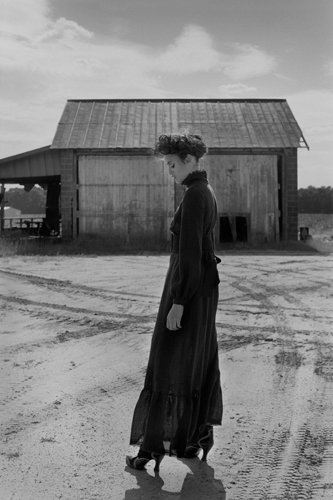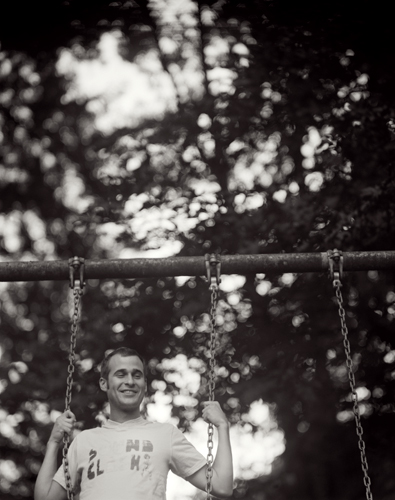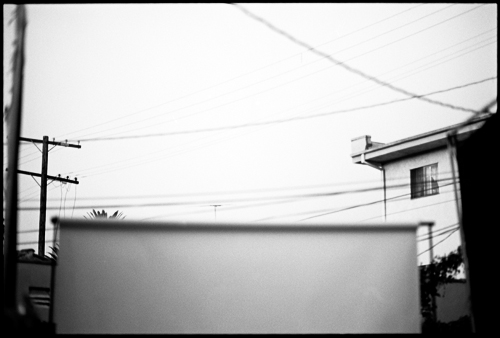FAQ: camera for fashion photography? And the team on set?
Recently I had a photographer write me with two questions that I thought would be worth discussing here, as I think they’re common questions and good questions.Â
Question “1) [w]ith so many formats available (e.g., 35mm, medium format, and large format), what guides your decision on which format you shoot with for an assignment? I know that the output print size is a major part of the decision as well as portability and ease of use. But are there any other issues that you consider?”
Format is something I consider with every shoot, but it’s hard to explain any logic in this choice b/c only about 17% of the decision is logical. The other %83 is a arcane go-by-my-gut sort of deal. I think most photographers are like this, and that’s why we’re all vastly different in how we approach our gear. Some shoot three formats during the same job, some can only shoot one (I’m definitely of the latter category). So, vague answer: it is something you figure out over years of trial and error.
That’s boring though, so as a more specific and personal answer, I know that I shoot differently with each format and each format has a slightly different quality (less so with digital). These things are part of the process of achieving what I want the pictures to look like. Then I consider reproduction sizes (not as big a deal as most people think) and budget (a bigger deal than most people think) and other practical matters to further direct these considerations. It’s a mix of what’s practical and gets things done, and what feels right for the idea or the moon’s phase or whatever.

photo: 35mm fashion example. © Graeme Mitchell 2005.
It’s something you get relaxed about after a few years as you develop relationships with different cameras and learn that they’re a small part of the process. But I do understand when you’re starting out it can be nerve racking, as is the simple questions of what film you should use, what light modifiers, on and on. I’ve two pieces of advice that worked very well for me in these regards.
First, do not loose sight of the big picture. Go ahead and write that on your mirror. In fashion and portraiture the key things are people, clothes, taste, ideas, light. Concentrate on these. Learn to understand how they work for you and how you work for them. The details of cameras and films and small stuff becomes a unnecessary distraction imo, b/c frankly they make much much less of a difference than we think they do. Yeah, you need to know what you’re doing b/c the photography part does matter, but it’s mostly stuff you learn from simple testing and playing around. A day of shooting will teach you more than a year of reading internet forums.
Second, (as a way of not getting wrapped up in the details), when you’re starting out I always suggest to radically simplify your gear. Pick one camera and shoot it for a few years. Learn to really control that system. Pick one film and one developer and master it. Pick one lens and master it. It is a way of teaching yourself how to bend the basics to your needs, and in doing this you learn the principals of the medium Then it’s like learning a second language; once you become fluent in one, others will come easily.
I did this out of necessity rather than choice. When I first moved to NYC I had sold most of my gear for money; not that I had room for it anyway (lived on couches), so all I had was my Nikons and a few lenses. And I was broke, so all I could afford to do was shoot black and white and process it myself. My back-to-basics wasn’t a pedagogical choice, rather a financial one, but I quickly saw the benefit of it in my work and it soon became a game: “if I can’t do something amazing with this camera and this film, then the problem is me and nothing else.” Your kit might be 8×10” and tmax 100, or a digital point and shoot, you’ll know when you hold it, but whatever it is use it until it’s as natural as…well, whatever comes naturally to you.

photo: 4×5 portrait w/ old optics. © Graeme Mitchell 2007.
Question “2) I’m planning for my first fashion story; it’s personal/portfolio work, so I’m simply shooting for myself and for my team. I have a team of five: two models, a hair stylist, a make-up artist, and me (the photog). What role do the hair and make-up artists play while the photographer is photographing the models? Are they usually with the photographer and the models during the shooting? Or are they out doing something else[…]”
As above, this all depends on you and what you’ve figured out for yourself over the years. It also varies job to job, set to set, mood to mood. Some photographers blast music and have groupies hanging out, others close sets and it’s just them and the model. For most I think it lies someplace inbetween depending on their personality, the shoot, and the team. I’ll close the set if things get distracting or I can tell the model would benefit from it. Personally, I prefer not to though. If I’m working with my usual team, or people I am confident in, then they’re all right next to my side and very much a part of the process of making pictures. The shoot is an open dialogue where everyone can contribute. This is important to me personally b/c it’s one of the reasons I was so interested in fashion photography, b/c it’s such a collaboration. For me, there’s nothing better than a good group of people just loosing themselves in making a cool image, totally open and honest, dishing and taking, and having fun. Again though, everyone and every shoot is different. As an example of a quirk that makes us all different: I love collaborating and that energy, but once I start burning film and concentrating on the model it has to be quiet; there can be music, but no distractions or pointless noise. Kind of weird, but a big deal. Obviously, for me, having so much faith in my team and wanting them to work so tightly with me makes them a specific sort of people and ones that took a long long long time to put together. And still, the dynamic and people are always shifting as life sees fit. You’ll meet all sorts of people shooting, some who you like and others your don’t like, all that affect the day, and all who you can learn something from.

photo: on set in L.A. © Graeme Mitchell 2006.
Still really haven’t answered the question have I? So, my suggestion in starting out with a team is to keep communication wide open, don’t be afraid to direct but also to let people do their thing, and most of all to watch what they’re doing so you can learn it, so you can begin to see what they’re seeing. If you’re into fashion you need to start to understand hair and make-up, and there’s not quicker way to learn it than while working with people on it.
As is my usual advice in receiving advice, often the smartest thing to do is to ignore it all and do what you want.
(Do any other fashion photogs visit this blog? If so, feel free to leave your answer’s or experiences about these questions in the comments. Because I’m not for a moment trying to persuade anyone I’m an authority of any sorts. More thoughts are better.)Â
Not only did you address the initial questions, you also addressed many unasked questions in the process. And yeah, I’m sure most of us will end up doing what feels natural to us, but those of us who are relatively new at this will likely benefit from your guidance. This ought to give us a starting point to navigate from (if you know what I mean). I don’t know about your other readers, but I feel a lot more comfortable about diving into a coordinated fashion shoot now, haha. And like you, I’d love to hear from other fashion photographers, too.
Oh, btw, I really think that the, “A day of shooting will teach you more than a year of reading internet forums,” line will really hit home, haha. At least, it better because I don’t feel that I shoot enough.
As always, thanks a lot! Your blog is an invaluable service!
Brandon
Really good advice Graeme, especially “In fashion and portraiture the key things are people, clothes, taste, ideas, light. Concentrate on these.”
That single comment sums up the most important thing you need to know when on a shoot, and it’s something that is often overlooked.
One thing that studying at London College of Fashion taught me was the ability to know your equipment. I forced myself to use the RB67 with the 80mm lens and only work with that, the experience it has given me has been amazing. I think we are all bombarded with this race to have as much kit as possible, zillions of megapixels handy and yet often the photographer is left with too many choices.
Often you only really need 1 lens and in most cases, 2 lights, but again this is in most cases and not all.
I don’t shoot fashion, but I do work with a regular team of people on editorial portrait jobs where a stylist may be involved, so my thoughts may still be relevant.
Re: Question #1
I’m not a super technical photographer, but I do love to play with new (or old) toys. For most jobs I end up sticking with my Canon digital, which is my most efficient tool, but also my least favorite to use. I’m a film guy to the core, but have found it difficult to get my current crop of clients to cover the lab bill, especially when it’s in the neighborhood of $2500 for the amount of film I’d shoot on any given assignment (that might be only paying a quarter of that amount for the actual page rate). But, as long as I cover my ass and use the digital, I’ll bring along anything from an RZ, Hasselblad, Lomo, Fuji rangefinder, or Speed Graphic just to get my kicks in and spread the cost of my film & lab bill among other line items. The choices in what toys to bring mostly come down to how much time I have with the subject, how mobile do I want to be, if I’m on location or in a studio, and how many assistants do I have that know how to load whatever it is I’m bringing (a surprisingly dying skill set). Like Graeme mentioned, output size has almost no bearing on any equipment decisions. If Juergen Teller can shoot campaigns with a G2, it shouldn’t matter to any of the magazines. If you’re unsure about scanning or paying for scans, remember that you can turn in C-prints for the magazine to handle and nobody will know the difference.
Re: Question #2
Test shoots are mainly collaborations, where everyone needs something for their book, so being flexible with the stylists is important. If they offer their opinions, listen to them before making any final decisions. Keep in mind that most people remember the photographer and rarely the stylists when reviewing images, so do your best to make the final call. Like with any team job, you’ll have to figure out how your stylists work. Some hair stylists jump in between every frame to make adjustments or will want more wind in the hair, some will just wait for you to say something while reading a magazine. The same goes for wardrobe, makeup, and set people. Personally, I prefer the proactive ones, especially since I’m slightly indecisive about hair styles or whatever while I’m focusing on all the other aspects of shooting, mainly working with the subject to build that connection.
Nice additions Daniel and Mr. T.
Mr. T, no doubt about the dieing breed of assistants who know how to load film, properly and quickly.
Daniel:
Yeah, I think I initially fell for the “YOU NEED THE BEST KIT ON THE PLANET! BUY! BUY! BUY!” mantra. When I first started, I spent a lot of time in the magazine section at my local book stores. Not only are most of the photography magazines [and books] geared towards digital, many of the magazines bombard viewers with stuff to buy. So, I nearly fell into the trap of thinking that I always needed to keep buying stuff in order to get the results I wanted. I really had to remind myself to ignore the ads (as cool as they are =D), and that I didn’t need anything else. I already have enough to get good results and then some, haha…
Mr. T:
Thanks for sharing your experiences, too. That’s a lot of useful info. And not only am I shooting for our portfolios in these test shoots, I really want to get a sense of how I can rely on and who I’ll want to work with on future projects. Best wishes to you!